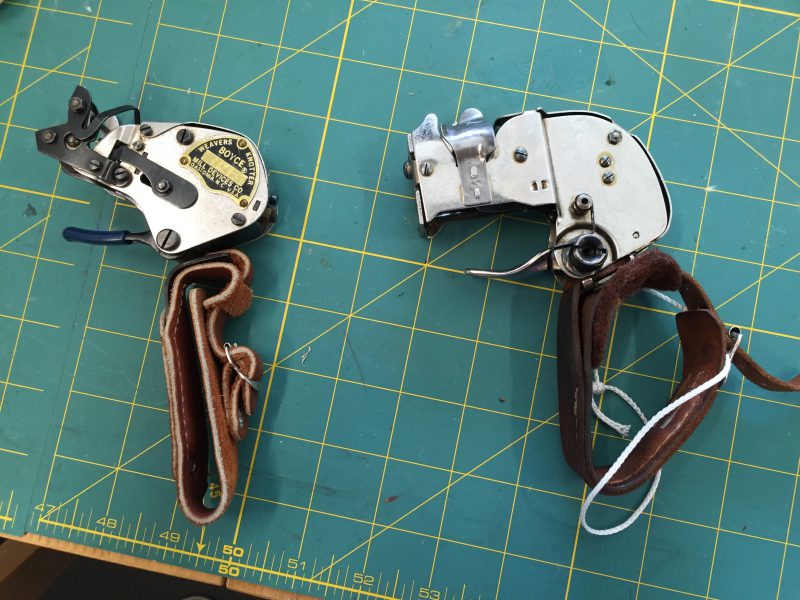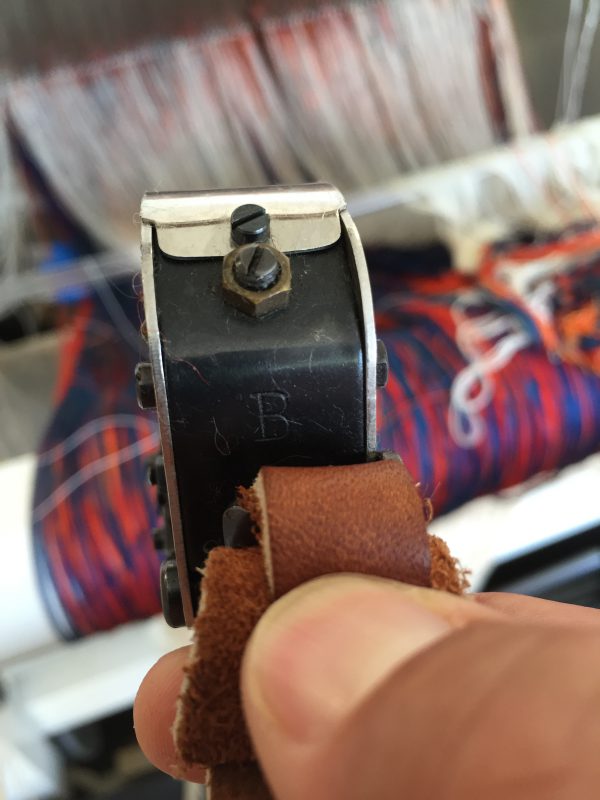I’ve started tying the new warp onto the old one, and since there are 880 knots to be tied, I’ve been testing out my knotting equipment. I have a Boyce weaver’s knotter, a Cook weaver’s knotter, and ten fingers, so I’m trying all three.
Both the Boyce weaver’s knotter and the Cook weaver’s knotter are used in weaving mills to tie threads together. It’s quick and easy – line up two threads, pull the trigger, and presto! a knot.
Here are the Boyce weaver’s knotter (left) and the Cook weaver’s knotter (right).

Boyce weavers knotters are quite common (occasionally found on eBay), but I’ve only ever seen one Cook weaver’s knotter for sale (I bought it). It functions very similarly to the Boyce weaver’s knotter, so I’m not posting separate instructions for the Cook version.
Since the Boyce weaver’s knotter is not especially intuitive to use, and instructions decidedly lacking, I decided to make a short video demonstrating how to use one:
It’s worth mentioning that Boyce weaver’s knotters are designed for different sizes of yarn. The type of yarn it’s designed for is indicated by a letter engraved on the back of the knotter:

And here are the ranges that correspond to each letter:
A – minimum 33,600 ypp, maximum 10,080 ypp
B – minimum 16,800 ypp, maximum 6,720 ypp
C – minimum 8,400 ypp, maximum 2,520 ypp
So this knotter is meant for yarns from 6,720 yards per pound to 16,800 yards per pound. (By way of comparison, sewing thread is about 12,000 yards per pound.)
One piece of advice: when the knot comes out of the knotter, tighten and test it before moving on to the next knot. I didn’t test mine thoroughly enough, and found that several gave way as I was trying to pull the knots forward through the heddles. Those are going to be frustrating to fix, so I’m being much more careful now.
I’m also experimenting with tying weaver’s knots by hand. Here’s the best video I’ve found about how to tie weaver’s knots:
https://www.youtube.com/watch?v=ySpWWUa7NLA
This video is great because the demonstrator is a technician at the Oriole Weaving Mill, meaning he ties these knots for a living. So he not only shows how to tie the basic knot, but explains several “tricks of the trade” to make tying the knot a lot faster. (Be warned that it does take practice: I’ve tied about 150 knots so far and am still working out the subtleties.)
So far I’ve found my hand-tied weaver’s knots stronger and more satisfying to make, but they’re also harder on the hands. I’m finding myself with sore thumbs, which means it’s important to take lots of breaks, since repetitive stress injuries are no fun. I’m sure it will get easier, though, as I learn to tie the knots correctly and my hands relax.

I’ve found the hand-tied knots are more reliable and just as fast as the ones using the Boyes device. It took lots of little bits of knotted yarn to reach that conclusion 😉
Thanks so much for sharing this information. Very helpful.
Linda
Thanks Tien!
Diane
Thanks so much. Very helpful.
Lauri
Very good instructional video. I like the knots also, tho’ I try my hardest to not need them! Thanks for posting here and on Weave Tech.